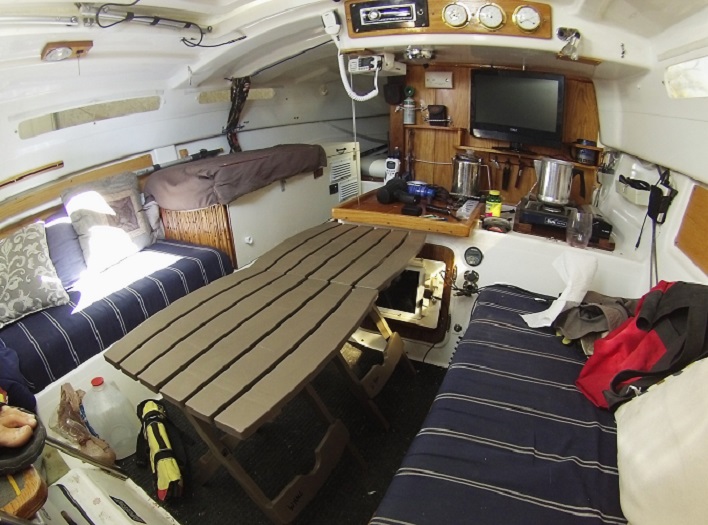
Custom Electric Fridge in a Macgregor 26S

Goal and discussion (Skip to the bottom if just looking for pictures)
I had built a two chamber ice chest in this boat (26S) previously (link to the two chamber ice chest) in the spot shown in the picture above. We sleep in the rear berths so this makes a great spot for cold storage. The two chamber ice chest sort of worked but ended up being mostly full of ice for long trips and the second chamber area was not really well utilized. The second chamber just by luck was about the perfect size to mount a compressor so I decided to modify this to a solar powered electric fridge. Lots of details to read below but my initial choice of panel size was 140 watts. However, the manufacture had a 160 watt panel same physical size so I am powering this with a 160 watt panel (link to the solar panel).
Also, I wanted to be able to leave this fridge on while the boat is sitting in a slip for months at a time without it working the batteries very hard and at the time of this writing have had this running continuously for about five months last year and so far two months this year.
In order to not work the batteries hard, I have a very simple custom circuit using a solid state relay that monitors the solar panel output voltage and turns the power to the fridge off when there is no solar. I.e., the power to the fridge is removed every night and turns back on first thing in the morning when the sun comes up (even very little sun will turn the fridge back on).
This has been used during the winter at Lake Havasu Arizona and it has really worked well. For this particular location and season of use, the 160 watts of solar power is way more than I need. However, excess solar panel power is not a bad thing as the more you have, the easier it is on the batteries. The closer you get to where the solar power generated is near the power used, the harder it will be on batteries as you will tend to dip into battery reserve more often.
In researching the power needs of a boat electric fridge, I found the numbers (usually given in "amp hours" which assumes a 12 volt system) varied all over the place. The reason for this.. it does vary all over the place. The amount of energy (power times time) lost through insulation is proportional to the temperature difference across the insulation times the R value. Since we are keeping the fridge inside temperature around 40F, you would lose twice as much "cold" at 80F compared to 60F (i.e., delta temp at 60F is 20 degrees. At 80F, delta temp is 40 degrees). Given there is some inefficiency in cooling, it might take THREE times the energy or power to operate the same fridge in 80F ambient compared to 60F. So the ambient temperature the fridge is used in makes a big difference. And of course the size of the fridge, insulation and use make a difference. Because of this, I have spent time measuring what this fridge does and its in the section below under measured results.
Hardware and electrical details
The fridge uses Isotherm GE 80 for the compressor and evaporator (cold) plate. This is a simple setup where the evaporator plate is inside the cold area and the compressor is in a well ventilated warm area. Input and output flexible coolant tubes connect the two parts. This setup came with an ISEC controller that looks at the battery voltage and works the compressor harder if the battery/ input voltage is high indicating a robust charging source. For example, during the day when the solar panel is cranking and with the battery voltage in the 13 to even 14 volt range, the controller might cool the fridge contents somewhat below what the thermostat is set at and in doing so, stores additional cool energy. Then when the battery voltage is lower (like when there are no charging sources), the controller goes as easy on the battery as possible. Is this a great thing.. don't know for sure since I have not owned a system without ISEC but it seems to work well and I haven't had any issues.
The circuit diagram showing how the night time power cut off works is below. I used a solid state relay that senses the solar panel voltage to switch power. You can generally find solar charge controllers that will turn power ON at night (for something like a night time anchor light) but I could not find a solar charge controller that had power on when the sun was shining and off when the sun went away. So I am using this custom circuit based on a solid state relay which is on its second year and has proven to work well. Plus this night time off implementation should work with any solar charge controller. FYI, the charge controller I am using is a Victron 75/15 (up to 75 volts and 15 amps). The 1.5K and 9.1K ohm resistors in the diagram below that implement "hysteresis" can be 1/8 or 1/4 watt 5%.


Measured results. How much power is used and size of solar panel needed.
Measured power consumption
I am measuring current and "accumulated current" or amp hours (current times time) with a Linklite battery monitor which I believe to be accurate. Since the monitor shunt is wired to measure current into the battery ground connection, the fridge power consumption test has to be done on a day where the fridge is the only load and there are no charging sources running during the test. In this case, I would start the test just before sunset when the batteries were fully charged and note the amp hour reading. Then I would cover the solar panel with a tarp to disable it and then come back 24 hours later and note the battery monitor amp hour reading change. This is mostly an accurate test, the only thing it does not account for is that the ISEC will run the fridge a little harder when there is plenty of charging current. But the charging current is all shut off during the test. The circuit that shuts the power off at night was disabled so the fridge ran for the whole 24 hours.
First 24 hour amp hour test was done Jan 15 in Lake Havasu Arizona where the high temp for the day was 73F and the low temp for the day was 50F and the nights longer. The fridge temp was set at 40F. During this 24 hour period, the fridge ONLY used 9.5 amp hours. That is a very small number but it illustrates the importance of the average ambient temperature.
This same test was repeated later in April where during a "warmer" spell where the high temp of the day was 91F and the low was 63F. Fridge temp was still set at 40F. During this 24 hour period, the fridge used 28.1 amp hours.
While the power consumption was surprisingly low in January at 9.5 amp hours, it jumped nearly a factor of 3X to 28.1 amp hours on a warmer day a few months later. This illustrates that the heat loss is proportional to the difference between ambient and 40F.
If I were asked what the amp hours used by my fridge in a day is, I would say it can be as low as 10 amp hours on a colder day and a guess at maybe even 40 amp hours on a warm or hot day. This is one of the reasons that when you ask people, numbers vary all over the map.. because they do vary all over the map.
Battery use and voltages on a typical day.
The intention of having the fridge power go off at night was to go as easy as possible on the batteries. So how well did this work? When in the slip for months at a time, I have the switch set so that the power to the fridge is removed right at the tail end of sunset. Unless I have been using the boat that day particularly near sunset when the solar output is decreased, the battery will be fully charged having gone through the daily cycle of bulk then float charging via the Victron solar charge controller. During the night when no power is applied, the temperature in the fridge will drift up a few degrees to the mid to high 40's F. As soon as the sun comes up and creates any voltage on panel, this is sensed and the power to the fridge is turned back on.
When first powered up at sunrise, the fridge will run continuously for some time until the inside temperature returns to 40F. I have watched this many times and the amp hour meter will show right around 2.5 amp hours down before the solar panel begins to provide both the power for the fridge and to start charging the batteries back up. By early morning the batteries will be going through the daily multi stage charging routine (the solar charge controller automatically does this every day). For the rest of the day, the solar is providing all the power for the fridge and maintaining the batteries as if the fridge load was not even there.
My battery is composed of two six golf cart batteries for a total capacity a little over 200 amp hours. So my daily draw down to run the fridge when I am not at the boat is only 1.25 percent of capacity. The batteries are now on their fourth year and second year of running the fridge 24/7 for five months so at least at the moment, I think this setup is going easy on the batteries.
We have also spent nearly a week on the boat in Southern California with the fridge running and the even on a days with some clouds, the batteries were fully charged by afternoon every day. There of course could be conditions where I don't get enough solar charge but they will be rare and easily handled by just buying a bag of ice and turning off the power switch. I have not even come close to finding that threshold yet. The electric fridge has a very accessible drain in case of needing to add ice and to aid cleaning.
Did the automatic circuit that turns the fridge off at night (no solar) make much of a difference on being easy on the batteries?
With the automatic night time power shut off to the fridge, the batteries drain to a maximum of around 2.5 amp hours first thing in the morning before the solar panel both runs the fridge and recharges the batteries. A test was done on a night with a temperature that got down to the low 60's F where the fridge was left on all night. For the condition where the fridge was left on, the battery monitor showed around 9 amp hours used before the solar panel started to both run the fridge and recharge the battery.
So with the power turn off, the daily discharge is about 2.5 amp hours. Without the power turn off, the daily discharge is 9 amp hours. Is this significant? Probably not if it only happened one time and its hard to say if this level of discharge happens every single day (which is the case). But.. I would do it this way again for this application.
Picture below - this was taken early in the morning when the power circuit first kicked on and the fridge started back up. The sun had not come up over the horizon yet.

How much solar panel power do I need with a fridge?
A long time ago on a forum, I saw a rule of thumb to predict solar output that I like and have been using since then. This simple rule of thumb is that solar panel output per day (12 volt panel) in amp hours would be 0.2 to 0.5 times the rated power in watts. We will call that .2 to .5 the "scale factor". Now .2 to .5 is a large range but solar output also varies a lot depending on time of year, temperature, cloud cover, panel pointing etc. Example of how this works. Lets say we use the low end scale factor of .2. A 100 Watt panel would then produce 20 amp hours per day (100W*.2 = 20). At the high end of .5, a 100 Watt panel would produce 50 amp hours. I personally like this method for estimating solar output and actually measured a scale factor of a little over .3 one time with a MPPT controller.
Lets assume that we are using the solar panel in an area during the summer (warm) that gets afternoon clouds so the solar output would be on the lower end so we will assume a scale factor of .25. I.e., in this case, we would assume a 100 watt panel would produce 25 amp hours each day.
Now compare this to the fridge power use range of 10 amp hours per day to 40 amp hours per day and assuming the scale factor of .25. We can find the required panel watt size by the equation Panel watt rating = amp hours used / .25 (.25 is the assumed "scale factor described above).
For 10 amp hour fridge load case, Panel power = 10/.25 = 40 watts.
For the 40 amp hour fridge load case, Panel power = 40/.25 = 160 watts.
Once again the answer for how much solar panel is needed is "it depends" and the numbers calculated above don't account for all the other amp hour loads the boat might have which could be an additional 20 amp hours.
In my Arizona winter time application plus a near week long trip to the S. California coast, the 160 watt panel and this fridge has lots of margin and is more power than I need. But as noted before, a little extra solar ends up going easier on the batteries and they should last longer. Less margin of generated power to used power tends to use the batteries more.
How many amp hours are needed to cool one 12 OZ soda or beer from room temp to 40F?
In theory, if the contents inside the fridge are at the desired temperature and stable, the volume or amount of the content inside the fridge should have little impact on how much power the fridge uses. What does matter is how much energy is lost through the insulation and also how much power is needed to cool new additional items added to the fridge. In the measurements above, nothing was added or removed during the test so only show the affects of energy loss through the insulation. But not how much power is needed if items are added to the fridge.
An interesting and possibly easiest to calculate data point is how much power is required to cool 12 oz. of water from room temp (70F) to 40F. I'm assuming that beer and soda have a mass and specific heat close to water so believe this also applies to beer and soda.
Details of the calculation
Mass of 12 oz. water is .354 KG, specific heat of water is 4.19 KJ/KgC
Temperature delta (75F to 40F) is 16.67C. The equation is: Q(energy in KJ) = specific heat * mass in Kg * delta temp in C
Q (energy in KJ) = 24.74 KJ (Conversion 1KJ = .277 Watt hours) = 6.853 Watt hours
At 12 volts, 6.853 Watt hours is .571 amp hours.
So in theory it takes .571 amp hours to cool one 12 oz. can of water (or beer). I don't know exactly what the efficiency of the electric fridge achieves but I'm going to go with that it takes about 1 amp hour of energy if a room temperature 12 oz. container of water is added to the ice chest.
Pictures and construction
Insulation thickness: Side wall and top cover - 2 inch thick insulation. Floor and partition between chambers - 3 inch thick insulation
Volume of the fridge cold area is 1.886 cubic foot or 56.45 quarts. The total length of the whole assembly is 4 ft.
Below. The cold plate at least looks somewhat fragile and "stuff" gets thrown around in the ice chest while sailing so the AL angle and AL solid bars protect the cold plate from damage.
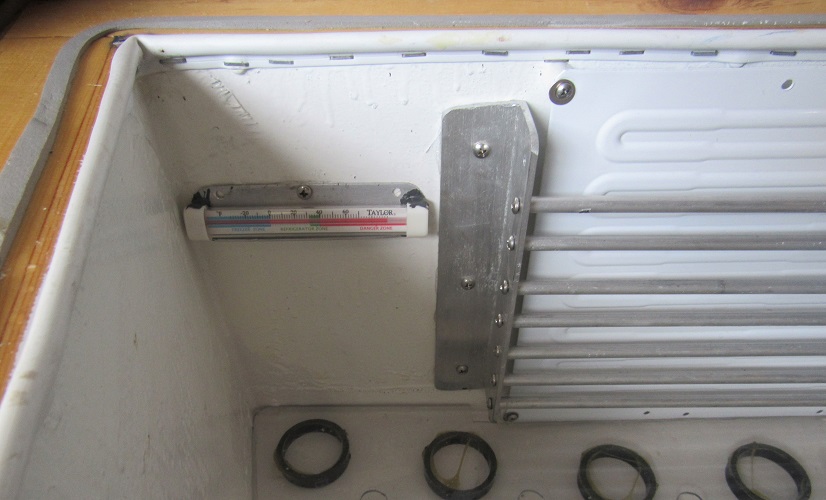
Below. The compressor needs very good ventilation with both easy cool input flow from lower area to easy warm output flow from higher up. I "believe" the efficiency of the fridge is at least somewhat dependent on how well hot air is vented away from the compressor area.
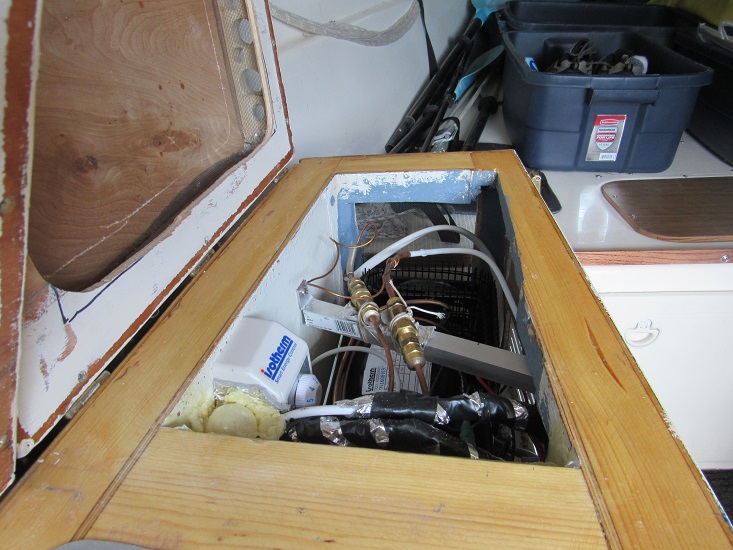
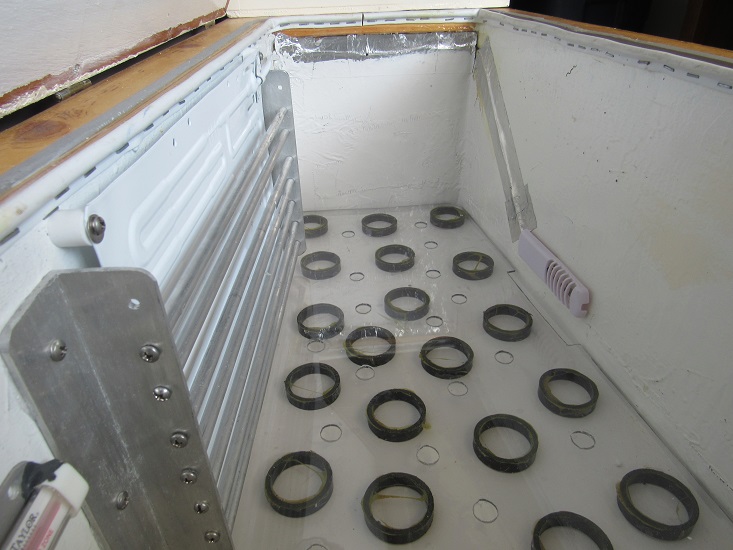

Below. The top cover has ventilation holes on the two sides that are not normally visible.
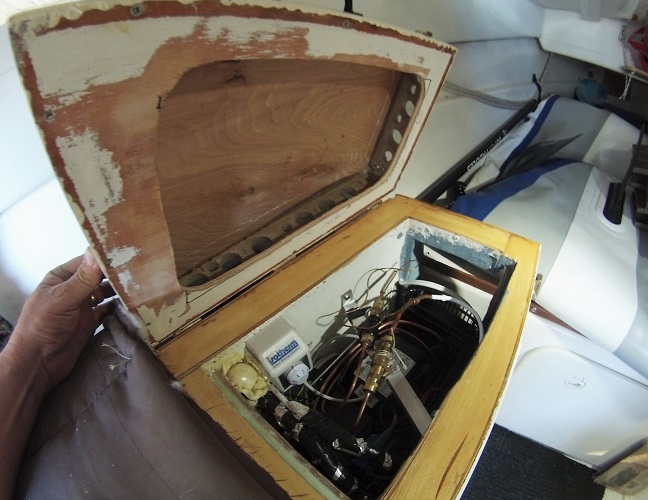
Below. The whole back side is open with a screen cover for best air flow.
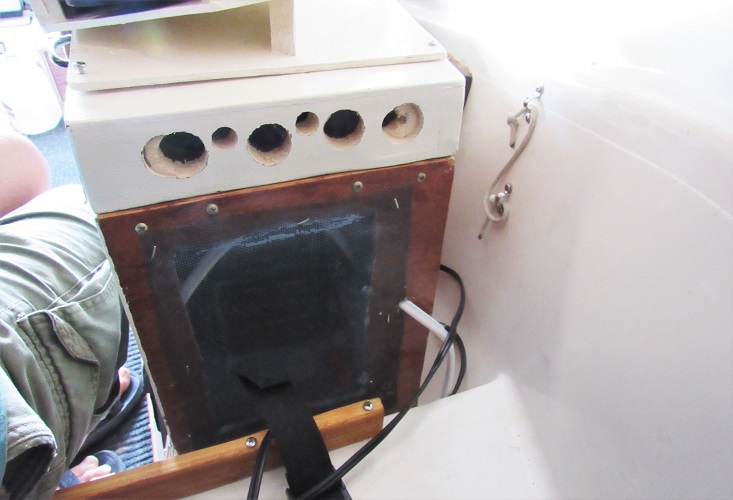
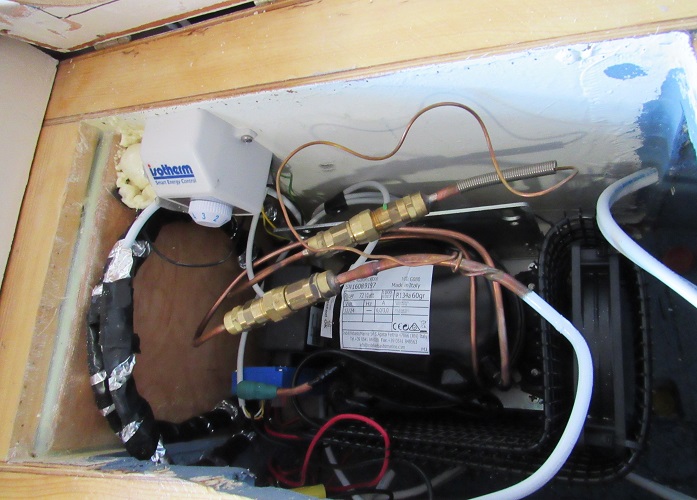
The fold out tables also get used for on the dock parties. Easy access to the fridge from where we hang out in the cabin.
